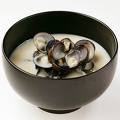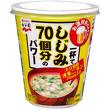::::::::::::::::::::::::::::::::::::::::::::::::::::::::::::::::::::::::::::::::::::::::::::::::::::
Soups of Japan ... shiru 汁
There are many different types, from a small delicate bowl to a huge noodle soup meal.
Slurping whilst eating is part of the etikette.
::::::::::::::::::::::::::::::::::::::::::::::::::::::::::::::::::::::::::::::::::::::::::::::::::::
Shirumori Jinja 汁守神社(しるもりじんじゃ)
Shrine Shirumori, the protector of soups
川崎市麻生区(神奈川県) Kawasaki Town, Kanagawa prefecture
On the first shrine visit during the three days of the New Year, the people born in zodiac sign of that year get a hot pork soup.
They pray for a good harvest and good luck in the New Year.
Then there is a lion dance for the Gods (and the visitors) to enjoy.
There is also a drum group performance.
Kurokawa Hayashi ren 「黒川囃連(はやしれん)」
. . . CLICK here for Photos !
The deity here is Ukemochi no Mikoto
保食命(うけもちのみこと)。
UKE is an old reading for UKE, meaning food. He is the tutelary deity of food.
Legend knows this :
Ukemochi was killed by Tsukiyomi no kami (venered deity at Mount Gassan (moon mountain)), because he did not keep the vegetable grains in clean condition. This lead to a fight betewen Tsukiyomi (moon) and Amaterasu (venered as Sun deity in Ise).
大己貴命、素戔鳴尊 are also enshrined here.
Even her dead body produced food:
millet, rice, and beans sprang forth. Her eyebrows even became silkworms.
. Uke Mochi and the Silk connection.
The main hall has been re-erected in 1782. The compound is large, more than 6000 square meters, and full of lush old trees.
quote
Ukemochi no Kami
A deity appearing in an "alternate writing" quoted within Nihongi. The name uke is synonymous with uka, meaning "food," with the result that ukemochi no kami means a tutelary of foodstuffs, although some theories suggest that the kami is identical to Ōgetsuhime. According to Nihongi, Amaterasu commanded Tsukuyomi to go to Ukemochi, whereupon Ukemochi produced various foods from her mouth, including "things broad of fin" and "things narrow of fin," "things rough of hair" and "things soft of hair," and these she presented on one-hundred serving tables as a feast to Tsukuyomi.
Tsukuyomi, however, was enraged at being served foods that were "polluted" (since they had issued from Ukemochi's mouth), and drew his sword and killed Ukemochi. Hearing of this, Amaterasu sent Amenokumanoushi to investigate; it was found that cattle and horses were produced from the head of Ukemochi's dead body, rice was produced from her belly, and wheat and beans were produced from her genitals. Amenokumanoushi took these items to Amaterasu, who was pleased, saying that the foods would serve to feed human beings. Amaterasu planted the various grains and seeds in fields and paddies, a story said to represent one type of food-origin myth.
source : Nakayama Kaoru, Kokugakuin 2005
The Deity Ukemochi no Mikoto 保食命 is also venered at many other shrines in Japan.
. . . CLICK here for Photos !
There is also a shrine called
Meshimori jinja 飯守神社 Protector shrine of cooked rice
in the Musashino Plain.
. . . CLICK here for Photos !
::::::::::::::::::::::::::::::::::::::::::::::::::::::::::::::::::::::::::::::::::::::::::::::::::::
atsumono あつもの(羹) hot soup, served after a main meal to accompany drinking
Chankonabe ちゃんこ鍋 hodgepodge for Sumo wrestlers, made from chicken stock, not dashi.
Sumo, a KIGO for Haiku
SUMO : More in the WIKIPEDIA !
. . . CLICK here for Photos !
Sumoringen
Dashi, soup broth, made with little dried sardines (niboshi) or konbu kelp seaweed. Shavings of dried bonito (katsuobushi) are also used.
Soup stock (dashi, だし、 出し)
Fukahire suupu ふかひれ (鱶鰭) sharks finn soup, Chinese type
. fukuro no atsumono 梟の羹 (ふくろうのあつもの)
"hot soup with owl meat"
kigo for mid-summer
Gojiru 呉汁 with soy beans from Hokkaido
soy beans are soaked in water over night, then mashed in a mortar or electric blender and the cream is added to miso soup, turned to low heat. When the soup comes back to a boil, stop heating and serve, with some greens on top.
Insutanto インスタント ready-made soups
in a container, just to poor water on it.
kakitamajiru かきたまじる / かき玉汁 clear soup with an egg
. . . CLICK here for Photos !
Kappu raamen カップラーメン cup noodle soup
Karee suupu, suupu karee カレースープ curry soup and soup curry
karee カレー curry and many curry dishes
Kenchinjiru けんちんじる(巻繊汁) vegetable soup
first prepared at temple Kenchoji in Kamakura, Kanagawa
also speciality of Yamanashi
kigo for winter
English recipe
Komaijiru 氷下魚汁(こまいじる)soup with saffron cod
kigo for all winter
Mozukujiru もずくwith mozuku seaweeds
Nemacystis decipiens; 〔もずく料理〕mozuku;
an alga-like seaweed often served in a vinegary sauce
Misojiru, 味噌汁 みそじる miso soup
, often served with tofu and other GU, ingredients.
see miso
nabe 鍋 なべ hodgepodge, a kind of thick soup
It comes in various flavors of all regions, special food of the winter season.
tomato nabe トマト鍋
Eintopf
Potaaju ポタージュ potage, vegetable soups, Western style
Ramen, raamen ラーメン Chinese noodle soup
Sakekasujiru 酒粕 with sake lees
well liked in winter to keep the body warm.
:::::::::::::::::::::::::::::::::::::::::::::::::::::::::::::::::::::::::::::::::::::::::::::::::::::

Shijimijiru 蜆汁, しじみ汁 miso with corbicula clams
brackishwater clam, short-necked clam, Yamato-Shijimi (Corbicula japonica)
corbicula miso soup
It is said to be good for your liver and helps with a hangover.
In the towns of the Edo period, young kids would catch these small clams in the nearby lakes and sell them in the morning for the miso soup. The call of "shijimiiii, shishimiiii" was heared everywhere in Edo.
 It is one of the "tasts of mother" that are always remembered.
It is one of the "tasts of mother" that are always remembered.Now also awailable as "cup soup" or in deep-frozen preparations.
shijimi wakame soup しじもわかめスープ
Suppe mit Körbchenmuscheln
corbicula from Seta (Seta shijimi 瀬田蜆)
shijimi soup, kigo for all spring
:::::::::::::::::::::::::::::::::::::::::::::::::::::::::::::::::::::::::::::::::::::::::::::::::::::
Shiru, ... jiru, general word for many soups
soba そば Chinese noodle soup
soba 蕎麦 buckwheat noodles
Soppu chanko ... そっぷ ちゃんこなべ (ちゃんこ鍋)
Sumo wrestlers soup stew with chicken pieces to give them stamina. soppu means "sumo", but here also "chicken".
Soy milk chowder
Suimono, osuimono clear soup served in small bowls
Prepared with dashi.
Reference ONLINE
suiton すいとん / 水団 dumpling soup
Since the Muromachi period.
speciality of various prefectures
Washoku : suiton
Sumashijiru, clear soup, consomme, broth
osumashi お澄まし clear broth
sumasu 澄ます means the clearing of water, as an autumn kigo.
Water clears, clear water (mizu sumu 水澄む) .
It can also refer to the highbrow attitude of people.
Prepared with dashi of konbu and shiitake mushrooms. Ingredients added to the soup should be cut up and warmed in a separate stock.
Reference ONLINE
Taipiien 太平燕(たいぴーえん)harusame noodle soup
speciality of Kumamoto
. . . CLICK here for Photos !
TEN GU jiru, 十具汁 TENGU soup Sakaide, Shikoku
Ton-jiru, 豚汁 pork soup, tonkotsu jiru
Udon うどん 饂飩 ウドン Udon noodle soup
Ushiojiru うしおじる(潮汁) sea shell soup, clear fish soup
clear clam soup, fish soup, ...
slightly salted broth with freshly boiled fish from the seaside, including tai, hamaguri, tai and suzuki.
klare, salzige Suppe aus Fischen und Muscheln
. . . CLICK here for Photos !
hamaguri clams are the symbol for a happy marriage, so this soup is often served on March 3, the Doll Festival for girls.
Made with or without dashi, sometimes adding a pinch of seasalt to increase the sea flavor.
Zoni, zooni 雑煮 soup for the New Year
::::::::::::::::::::::::::::::::::::::::::::::::::::::::::::::::::::::::::::::::::::::::::::::::::::
ukimi うきみ、浮き実 "things floating on a Western soup"
To give an accent in taste and for looking pretty.
Mostly crouton (クルトン), french:julienne (ジュリエンヌ), paseri パセリ parsely or guriin piisu グリーンピースgreen peas
. . . CLICK here for Photos !
In a Japanese soup, it is called wanzuma 椀づま / 椀妻.
:::::::::::::::::::::::::::::::::::::::::::::::::::::::::::::::::::::::::::::::::::::::::::::::::::
Guide to traditional Japanese soups
by Ken Tanaka
Like most the rest of East Asia, the Japanese enjoy hot soups with their meals. Soup is taken in a small decorative bowl known as an owan, placed on the right hand side of the consumer opposite the rice bowl.
by B. Iris Tanner
Japanese soups range from simple, clear broths to the thick, velvety texture of kambocha pumpkin soup to the complexity of a chankonabe soup - a one-pot meal designed for sumo wrestlers.
by Betsy Young
There are four bases for soup in Japanese cooking, clear broth, clear broth with miso, soy milk with sweet white miso and egg custard. Everything else is a variation on these themes.
Read the full articles here:
source : www.helium.com/knowledge
*****************************
Worldwide use
*****************************
Things found on the way
*****************************
HAIKU
Hokku about soup by
. Matsuo Basho 松尾芭蕉 - Archives of the WKD .
:::::::::::::::::::::::::::::::::::::::::::::::::::::::::::::::::::::::::::::::::::::::::::::::::::::::
Kobayashi Issa in Choshi 銚子, Chiba
朝涼や汁の実を釣るせどの海
asasuzu ya shiru no mi o tsuru sedo no umi
morning cool --
in the ocean out back
they catch fish for soup
Kobayashi Issa
Comment by Chris Drake :
The first version of this hokku was written on 6/1 (in July) in 1817, when Issa visited Choshi, a fishing town on the Pacific coast about 80 miles northeast of Edo. That version has "evening cool" in the first line. Issa's diary says he visited the Pure Land sect temple Jookokuji (浄国寺) Jokoku-Ji, or Pure Country Temple, in Choshi on 6/1 and that he went to a lookout point near the temple. That observation point had a view of the Pacific in the east, and it is behind the temple, so the location matches that in the hokku. The lookout point also had (and has) a pavilion facing westward for meditating on the setting sun and the Pure Land beyond the setting sun, a traditional form of Tendai-sect "sun meditation" that was continued and given a deeper meaning by Honen.
From this lookout point Issa could apparently see boats out in the Pacific fishing at the end of a hot summer day. He says the fish will be cut into pieces and served in soup, presumably miso beanpaste soup, which was cheaper than sushi. In the later variant of the hokku, translated here, the time has changed to early morning, when it is still cool.

memorial stone for Issa at temple Jokoku-ji 浄国寺
:::::::::::::::::::::::::::::::::::::::::::::::::::::::::::::::::::::::::::::::::::::::::::::::::::::::
堅田にはゆふべに着きぬ蜆汁
Katata ni wa yuube ni tukinu shijimijiru
I arrived at night
at the town of Katata ...
corbicula miso soup
Yamashita Kimio 山下樹実雄
WKD : Katata (Katada) town at Lake Biwa
*****************************
Related words
WASHOKU : Soups in Detail
WASHOKU : Soups as KIGO
***** WASHOKU : General Information
[ . BACK to DARUMA MUSEUM TOP . ]
[ . BACK to WORLDKIGO . TOP . ]
:::::::::::::::::::::::::::::::::::::::::::::::::::::::::::::::::::::::::::::::::::::::::::::::::::::




2 comments:
.
bejiburosu, beji burosu ベジブロス
vegetable broth
.
音たてて組む卓袱台や蜆汁
oto tatete tatamu chabudai ya shijimi-jiru
with a loud noise
she folds the tatami table -
corbicula clam soup
Horii Yoriko 堀井より子
.
more about chabudai
.
Post a Comment